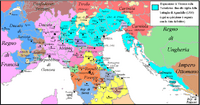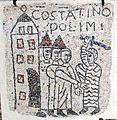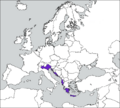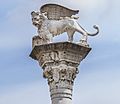Republic of Venice facts for kids
Quick facts for kids
Most Serene Republic of Venice
|
|||||||||||||
|---|---|---|---|---|---|---|---|---|---|---|---|---|---|
| 697–1797 | |||||||||||||
|
Motto: Pax tibi Marce, evangelista meus
"Peace be to you Mark, my evangelist" |
|||||||||||||
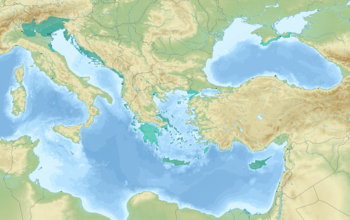
Diachronic map of the Republic and the Venetian Empire.
|
|||||||||||||
| Capital | Eraclea (697–742) Malamocco (742–810) Venice (810–1797) |
||||||||||||
| Common languages | |||||||||||||
| Government | Parliamentary oligarchic merchant republic with elective monarchistic features | ||||||||||||
| Doge | |||||||||||||
|
• 697–717 (first)
|
Paolo Lucio Anafestoa | ||||||||||||
|
• 1789–1797 (last)
|
Ludovico Manin | ||||||||||||
| Legislature | Great Council | ||||||||||||
|
• Upper Chamber
|
Senate | ||||||||||||
|
• Lower Chamber
|
Council of Ten | ||||||||||||
| Historical era | Middle Ages – Early modern period | ||||||||||||
|
• Established1
|
697 | ||||||||||||
|
• Golden Bull of Alexios I
|
1082 |
||||||||||||
| 1177 | |||||||||||||
|
• Sack of Constantinople
|
1204 | ||||||||||||
|
• Battle of Motta
|
1412 | ||||||||||||
| 1571 | |||||||||||||
|
• Treaty of Passarowitz
|
1718 | ||||||||||||
| 1797 | |||||||||||||
| Currency | Venetian ducat Venetian lira |
||||||||||||
|
|||||||||||||
| Today part of | Italy Slovenia Croatia Montenegro Albania Greece Cyprus Turkey Ukraine |
||||||||||||
|
a. ^ Paolo Lucio Anafesto is traditionally the first Doge of Venice, but John Julius Norwich suggests that this may be a mistake for Paul, Exarch of Ravenna, and that the traditional second doge Marcello Tegalliano may have been the similarly named magister militum to Paul. Their existence as doges is uncorroborated by any source before the 11th century, but as Norwich suggests, is probably not entirely legendary. Traditionally, the establishment of the Republic is, thus, dated to 697 AD.
|
|||||||||||||
The Most Serene Republic of Venice (Italian: Serenissima Repubblica di Venezia, Venetian: Republica de Venesia), was an Italian state where current Venice is now.
It existed for one thousand one hundred years, from the late 7th century until the late 18th century (1797, when it was conquered by Napoleon).
It was an important economic and trading power which was ruled by a leader called a doge.
Images for kids
-
The Doge of Venice, illustrated in the manuscript Théâtre de tous les peuples et nations de la terre avec leurs habits et ornemens divers, tant anciens que modernes, diligemment depeints au naturel. Painted by Lucas d'Heere in the 2nd half of the 16th century. Preserved by the Ghent University Library.
-
The sack of Constantinople in 1204 on a mosaic in the San Giovanni Evangelista church in Ravenna, 1213
-
Leonardo Loredan, Doge of Venice during the War of the League of Cambrai.
-
The Venetian fort of Palamidi in Nafplion, Greece, one of many forts that secured Venetian trade routes in the Eastern Mediterranean.
-
Siege of Tyre (1124) in the Holy Land
-
Voyage of Marco Polo into the Far East during the Pax Mongolica
-
The Piraeus Lion in Venice, in front of the Venetian Arsenal
-
Relief of the Venetian Lion on the Landward Gate in Zara (Zadar), capital of the Venetian Dalmatia
-
Vicenza, Piazza dei Signori.
-
Udine, Piazza Libertà.
-
Relief of the Venetian Lion in Cattaro (Kotor)
-
Relief of the Venetian Lion in Candia (Heraklion)
-
Relief of the Venetian Lion in Frangokastello, Crete
-
Venetian blazon with the Lion of Saint Mark, as frequently found on the New Fortress walls, Corfu.
See also
 In Spanish: República de Venecia para niños
In Spanish: República de Venecia para niños




